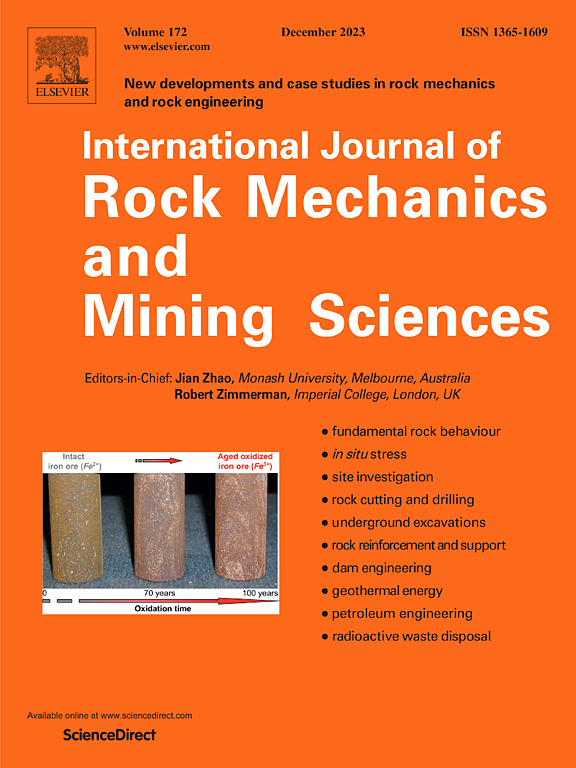轴镗床双盘刀刀盘锥角对破岩影响的研究
IF 7.5
1区 工程技术
Q1 ENGINEERING, GEOLOGICAL
International Journal of Rock Mechanics and Mining Sciences
Pub Date : 2025-04-29
DOI:10.1016/j.ijrmms.2025.106127
引用次数: 0
摘要
地球深部资源的开发利用已成为人类必须解决的战略性科技问题。竖井是通往地下深处的重要通道,全工作面掘进机是机械化竖井施工的关键。本文通过对SBM独特的锥形刀盘的分析,探讨了盘式刀盘破岩效率低的问题。以平刃刀具为例,建立了考虑刀盘锥角参数β的力学模型。对接触区压力分布进行了精确分析,得到了不同β角作用下岩石表面压力分布的解析解。该模型用于跟踪岩石内部不对称Von Mises应力分布的演化过程。通过数值模拟和侵彻试验,揭示了锥形刀盘作用下岩石的应力场、应变场和破裂场的对称破碎机理和特征。结果表明,在双盘式切刀穿透下,岩石破坏具有明显的不对称性。此外,切割轴左侧的岩石破碎区域比右侧大,特别是在下盘周围。随着角β的增大,不对称性更加明显,岩石总破碎面积迅速减小。当β从0°增加到60°时,岩石破碎面积和比能耗分别减少53%和18%。然而,能耗的减少明显小于破损面积的减少。因此,刀盘设计应在保持有效岩屑去除的同时,将β减小到60°角以内。研究结果为轴向镗床刀盘结构的设计奠定了理论基础。本文章由计算机程序翻译,如有差异,请以英文原文为准。
Study on the influence of cutterhead cone angle on rock breaking by double disc cutters in shaft boring machines
The development and utilization of deep earth resources have become a strategic scientific and technological issue that humanity must address. Shafts serve as the vital passage to the deep earth, and full-face shaft boring machines (SBMs) are crucial for mechanized shaft construction. In this study, the inefficiency of rock-breaking with disc cutters was investigated by analyzing the SBM's unique conical cutterhead. Specifically, a mechanical model accounting for the cutterhead cone angle parameter β was developed with a flat-edged cutter as an example. The contact area pressure distribution was precisely analyzed to derive the analytical solution for the pressure distribution on rock surfaces under different β angles. This model was employed to trace the evolution of the asymmetrical Von Mises stress distribution within the rock. Through numerical simulations and penetration tests, the symmetrical breaking mechanisms and characteristics of rocks under conical cutterheads were revealed regarding stress, strain, and fracture fields. The results specify that a marked asymmetry in rock failure occurred under double disc cutter penetration. Additionally, the rock breakage region on the left of the cutter axis was larger than that on the right, especially around the lower disc. As the angle β increased, asymmetry became more pronounced, and the total rock breakage area decreased rapidly. An increase in β from 0° to 60° brought about a decrease in the rock breakage area and the specific energy consumption by 53 % and 18 %, respectively. However, the reduction in energy consumption was significantly less than that of the breakage area. Thus, cutterhead design should minimize β to within an angle of 60° while maintaining effective rock chip removal. These research results lay a theoretical foundation for the design of the cutterhead structure of shaft boring machines.
求助全文
通过发布文献求助,成功后即可免费获取论文全文。
去求助
来源期刊
CiteScore
14.00
自引率
5.60%
发文量
196
审稿时长
18 weeks
期刊介绍:
The International Journal of Rock Mechanics and Mining Sciences focuses on original research, new developments, site measurements, and case studies within the fields of rock mechanics and rock engineering. Serving as an international platform, it showcases high-quality papers addressing rock mechanics and the application of its principles and techniques in mining and civil engineering projects situated on or within rock masses. These projects encompass a wide range, including slopes, open-pit mines, quarries, shafts, tunnels, caverns, underground mines, metro systems, dams, hydro-electric stations, geothermal energy, petroleum engineering, and radioactive waste disposal. The journal welcomes submissions on various topics, with particular interest in theoretical advancements, analytical and numerical methods, rock testing, site investigation, and case studies.

 求助内容:
求助内容: 应助结果提醒方式:
应助结果提醒方式:


